|
Back
A dazzling treat Toronto
Trinity-St. Paul’s Centre
01/31/2013 - & February 1, 2, 3, 2013
Giuseppe Antonio Brescianello: Orchestral suite in G Minor
Antonio Vivaldi: In furore iustissimae irae, RV 626 – Concerto for four violins in B Minor, op. 3, no. 10
Franceso Veracini: Orchestral suite in F Major
George Frideric Handel: Arias from Il trionfo del tempo e del disinganno and Giulio Cesare
Sandrine Piau (soprano), Julia Wedman, Patricia Ahern, Christopher Verrette, Cristina Zacharias (violins)
Tafelmusik Baroque Orchestra, Jeanne Lamon (leader) 
S. Piau (© Antoine Le Grand/Naïve)
What is certain to be regarded as a highlight of the season is Sandrine Piau’s dazzling performance with the Tafelmusik Baroque Orchestra.
In the first part of the concert she performs Vivaldi’s motet In furore iustissimae irae, a work in four contrasting sections: an agitated aria, a brief, pleading recitative, a second aria expressing heartfelt thanks, concluding with a showpiece Alleluia. Ms. Piau does more than just sing it - she seems to live it as each facet of the piece reveals itself.
The concert opens with a work from the byways of the repertory, the Orchestral Suite in G Minor by Giuseppe Brescianello, and also includes a suite by Francesco Veracini. Like so many Italian composers, they ventured north to serve at German courts (Stuttgart and Dresden, respectively), where they composed, among other works, suites in the French style. Each suite gives the orchestra ample opportunity to show off a contrasting array of tempi and dynamic playfulness.
The orchestral piece that simply takes ones breath away, however, is Vivaldi's Concerto for four violins in B Minor, one of the 12 concertos in his influential L’estro armonico. The whole ensemble plays this standing (as throughout the concert) and by memory, the result being that they all relate to one another constantly throughout. The result is a set of sonic acrobatics that would put the Cirque du Soleil to shame.
Ms. Piau earns her fee (a generous one, I hope) with the Vivaldi motet, but in the second half of the concert she puts Handel on display. The two concluding sections from the early oratorio Il trionfo del tempo e del disenganno, "Pure del cielo" and "Tu del ciel ministro eletto" are sung by Bellezza (Beauty) as she reconciles herself to the fact that youth and beauty must give way to time and disillusionment. Here Piau vividly expresses the stately melancholy of the piece, ably supported by the orchestra with its hypnotic pulse.
Her final part of the program features selections from Giulio Cesare. After the brief, vigorous Sinfonia bellica, she sings the plaintive acompagnato “Che sento” which leads into the languishing aria “Se pietà de me non senti”. This is followed by Cleopatra’s jubilant final aria, “Da tempeste il legno infranto”.
The audience responded with an old-fashioned grand furore and were rewarded with two encores by Handel: the dazzling "Tornami a vagheggiar" from Alcina, then a melting "Lascia ch’io pianga" which Handel used in both Il trionfo del tempo e del disinganno and Rinaldo.
It’s hard to believe Ms. Piau (the epitome of elegance and dramatic involvement, by the way) is performing such a huge program four times in as many days. It certainly is a treat for the local audience.
Michael Johnson
|